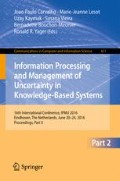Abstract
We present and analyze inference method called Perception-based Logical Deduction (PbLD) aimed at the treatment of fuzzy IF-THEN rules as linguistically expressed genuine logical implications. We analyze two variants of PbLD (original and balancing) that differ in the selection of fired IF-THEN rules. We concentrate on a situation when inputs into inference are fuzzy sets (fuzzy inputs). We study the conditions under which both variants fulfill the interpolativity property.
M. Štěpnička—This research was partially supported by the NPU II project LQ1602 “IT4Innovations excellence in science” provided by the MŠMT.
Access this chapter
Tax calculation will be finalised at checkout
Purchases are for personal use only
Notes
- 1.
We will call this degree a firing degree of the observation \(u_o\) in fuzzy rule \(\mathcal {R}_i\).
- 2.
E.g., extremely small is more specific than small.
- 3.
\({ LD}\) is viewed as a set, hence we omit multiple occurrences and each rule can be contained in \({ LD}\) only once.
- 4.
Compared to (7), where a single fuzzy relation has to be a solution of the whole system, here not all rules are fired and each equation is solved separately.
- 5.
When \(A_0\ne A_i\), not necessarily a single rule is fired. However, the original PbLD, compared to the fuzzy relational approach, notably reduces the number of fired rules.
References
Mamdani, E.H., Assilian, S.: An experiment in linguistic synthesis with a fuzzy logic controller. Int. J. Man Mach. Stud. 7, 1–13 (1975)
Dubois, D., Prade, H.: What are fuzzy rules and how to use them. Fuzzy Sets Syst. 84, 169–185 (1996)
Štěpnička, M., Bodenhofer, U., Daňková, M., Novák, V.: Continuity issues of the implicational interpretation of fuzzy rules. Fuzzy Sets Syst. 161, 1959–1972 (2010)
Zadeh, L.A.: Outline of a new approach to the analysis of complex systems and decision processes. IEEE Trans. Syst. Man Cybern. 3(1), 28–44 (1973)
Pedrycz, W.: Applications of fuzzy relational equations for methods of reasoning in presence of fuzzy data. Fuzzy Sets Syst. 16, 163–175 (1985)
Štěpnička, M., Jayaram, B.: On the suitability of the Bandler-Kohout subproduct as an inference mechanism. IEEE Trans. Fuzzy Syst. 18(2), 285–298 (2010)
Perfilieva, I., Novák, V.: System of fuzzy relation equations as a continuous model of IF-THEN rules. Inf. Sci. 177, 3218–3227 (2007)
Novák, V., Perfilieva, I.: On the semantics of perception-based fuzzy logic deduction. Int. J. Intell. Syst. 19, 1007–1031 (2004)
Dvořák, A., Štěpnička, M., Štěpničková, L.: On redundancies in systems of fuzzy/linguistic IF-THEN rules under perception-based logical deduction inference. Fuzzy Sets Syst. 277, 22–43 (2015)
Štěpnička, M., Dvořák, A.: On perception-based logical deduction and its variants. In: Proceedings of 16th IFSA World Congress/9th EUSFLAT Conference, pp. 341–350. Atlantis Press, Gijón (2015)
Novák, V.: A comprehensive theory of trichotomous evaluative linguistic expressions. Fuzzy Sets Syst. 159(22), 2939–2969 (2008)
Holčapek, M.: Monadic \(\mathbf{L}\)-fuzzy quantifiers of the type \(\langle 1^n,1\rangle \). Fuzzy Sets Syst. 159(14), 1811–1835 (2008)
Murinová, P., Novák, V.: Analysis of the intermediate quantifier “many” in fuzzy natural logic. In: Proceedings of 16th IFSA World Congress/9th EUSFLAT Conference, pp. 1147–1153. Atlantis Press, Gijón (2015)
De Baets, B.: Analytical solution methods for fuzzy relational equations. In: Dubois, D., Prade, H. (eds.) The Handbook of Fuzzy Set Series, vol. 1, pp. 291–340. Academic Kluwer Publ, Boston (2000)
Klawonn, F.: Fuzzy points, fuzzy relations and fuzzy functions. In: Novák, V., Perfilieva, I. (eds.) Discovering the World with Fuzzy Logic, pp. 431–453. Springer, Berlin (2000)
Perfilieva, I., Nosková, L.: System of fuzzy relation equations with inf-\(\rightarrow \) composition: complete set of solutions. Fuzzy Sets Syst. 159, 2256–2271 (2008)
Nosková, L.: Systems of fuzzy relation equation with inf-\(\rightarrow \) composition: solvability and solutions. J. Electr. Eng. 12(s), 69–72 (2005)
Perfilieva, I.: Finitary solvability conditions for systems of fuzzy relation equations. Inf. Sci. 234, 29–43 (2013)
Štěpnička, M., Jayaram, B.: Interpolativity of at-least and at-most models of monotone fuzzy rule bases with multiple antecedent variables. Fuzzy Sets Syst. (in press). doi:10.1016/j.fss.2015.09.013
Chung, F.-L., Lee, T.: A new look at solving a system of fuzzy relational equations. Fuzzy Sets Syst. 88(3), 343–353 (1997)
Author information
Authors and Affiliations
Corresponding author
Editor information
Editors and Affiliations
Rights and permissions
Copyright information
© 2016 Springer International Publishing Switzerland
About this paper
Cite this paper
Dvořák, A., Štěpnička, M. (2016). On Perception-based Logical Deduction with Fuzzy Inputs. In: Carvalho, J., Lesot, MJ., Kaymak, U., Vieira, S., Bouchon-Meunier, B., Yager, R. (eds) Information Processing and Management of Uncertainty in Knowledge-Based Systems. IPMU 2016. Communications in Computer and Information Science, vol 611. Springer, Cham. https://doi.org/10.1007/978-3-319-40581-0_40
Download citation
DOI: https://doi.org/10.1007/978-3-319-40581-0_40
Published:
Publisher Name: Springer, Cham
Print ISBN: 978-3-319-40580-3
Online ISBN: 978-3-319-40581-0
eBook Packages: Computer ScienceComputer Science (R0)

